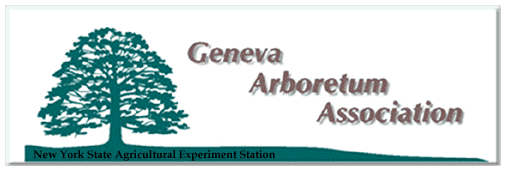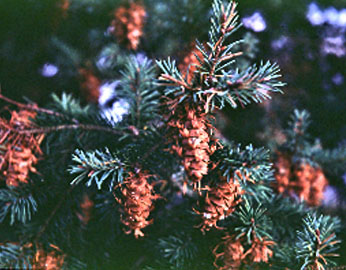

Many have heard of Douglas fir (Pseudotsuga menziesii) - perhaps it was your Christmas tree of choice this year - but what you probably did not know is that it is not a fir at all! It differs from true firs by having cones which are pendant, as in pines or spruces. True firs have erect cones, such as can be seen on the balsam, Nordmann and white firs on the Experiment Station campus. Another obvious difference is that Douglas fir cones have conspicuous 3-lobed bracts or "rat tails," which protrude beyond each cone scale, while true firs do not.
 Examination
of the cones on the evergreen trees behind the Stone Barn near the Sawdust
Cafe will reveal which are Douglas fir. Douglas fir needles (leaves) are
dark yellow-green, have a deeply grooved upper surface, two light lines
on the lower surface, persist for two to three years, and are twisted at
the base, giving a two-ranked appearance on the twigs.
Examination
of the cones on the evergreen trees behind the Stone Barn near the Sawdust
Cafe will reveal which are Douglas fir. Douglas fir needles (leaves) are
dark yellow-green, have a deeply grooved upper surface, two light lines
on the lower surface, persist for two to three years, and are twisted at
the base, giving a two-ranked appearance on the twigs.
The Douglas fir is the largest tree in the Northwest, second in size only to the giant redwoods of California. The long lived, stately Douglas fir has a conical or cylindrical shape and may live 800 to 1000 years, with a record height of 325 ft and 810 ft trunk diameter. In virgin forests, they average 180250 ft in height and 46 feet in diameter. Such stately specimens are anchored by a well-developed, widespread root system. In natural settings, the tree is an intermittent heavy seed producer (about every 6 years) and reaches maximum seed production only when it is between 200 and 300 years old. In years of light to medium seed production, no new seedlings may grow, as the seeds are eaten by squirrels, chipmunks and seed-eating birds. The buds are grazed by deer and other animals and the trees are also an important source of cover for wildlife.
Douglas fir was first observed by Menzies on Vancouver island when he accompanied the British naval captain, Vancouver, on his expedition to the Pacific coast in the 1790s. David Douglas, a Scottish botanist sent by the Royal Horticultural Society to collect plants in the US in 1825, discovered it again at Hudson's Bay. Both its discoverers are recognized in its common and Latin names. The species has also been known as "Oregon pine"; in fact, Douglas fir is the Oregon State Tree.
Douglas fir is the number one lumber producer in the US. The tree is valued for wood which is soft and light, strong, durable, straight-grained and tough, does not warp and takes a beautiful finish. It has been used extensively for telegraph and telephone poles, and for underlayment for thousands of miles of railroad track in the West. Perhaps your attic contains a WWII footlocker which were made, almost without exception, from this material. Douglas fir is also the primary wood used in the manufacture of plywood.
Douglas fir makes a good ornamental for gardens and parks in northern climates. It is best suited to deep, rich, well-drained loam soils. If you are looking for a different type of evergreen for your landscape, P. menziesii may be the tree for you.
by Cathy Heidenreich
Next (Magnolias: Part I)
Return to Arboretum Home Page
Return to NYS Agricultural Experiment Station Home Page
Page maintained by Thomas Björkman
Last modified January 21, 1998